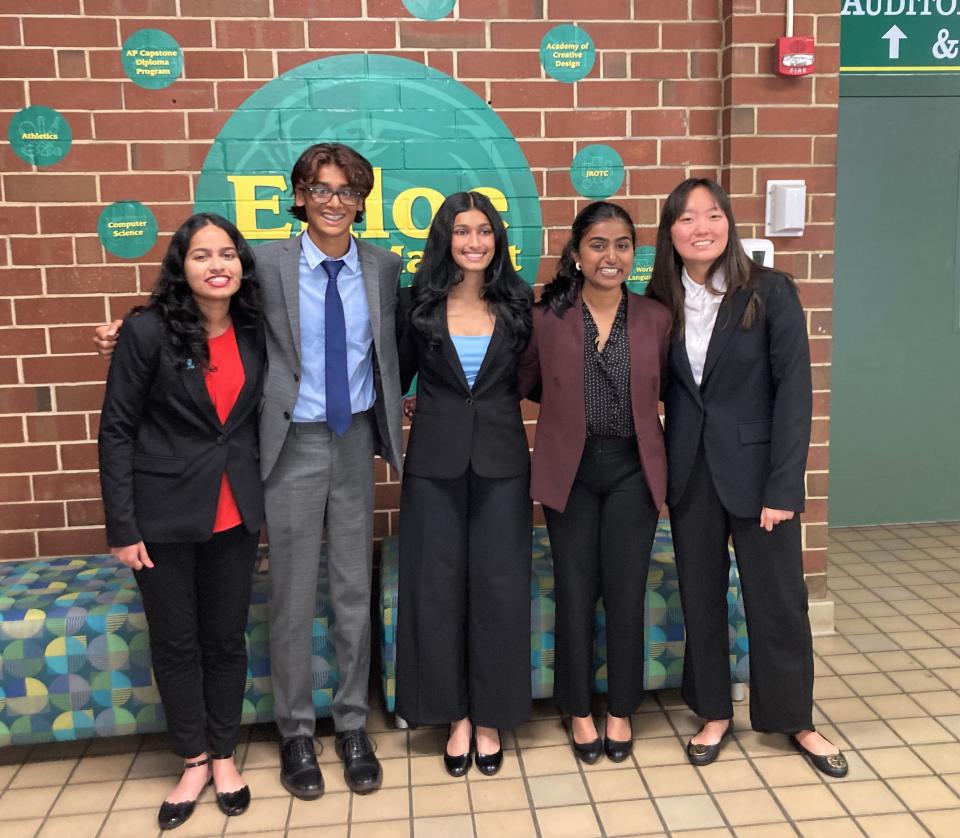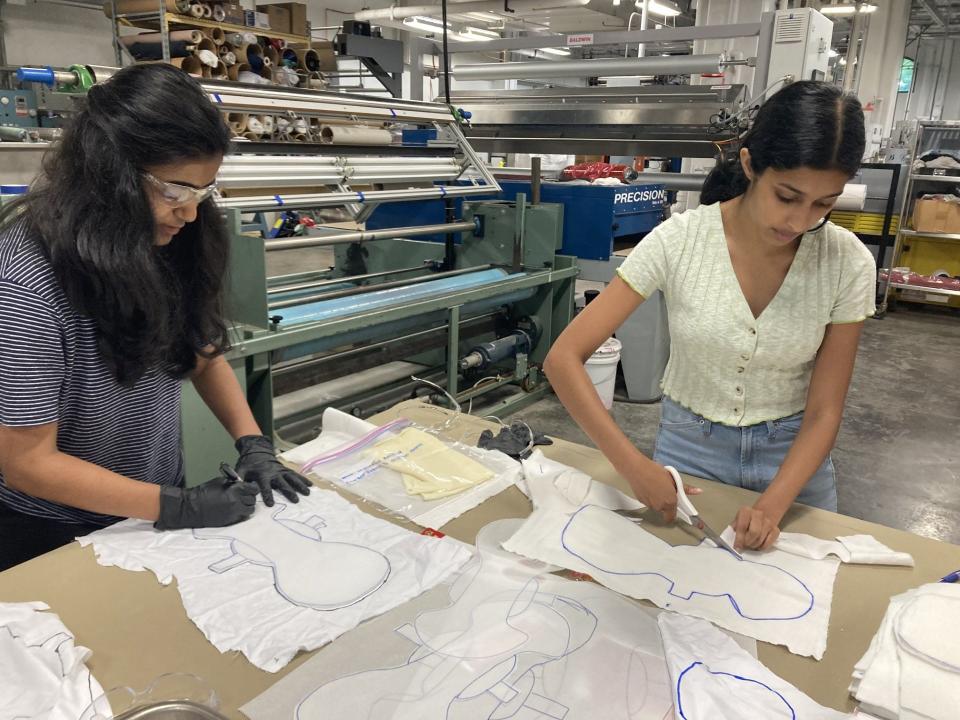A menstrual pad that tests for cervical cancer? These teens are inventing it
The teenagers launched into their well-rehearsed pitch in the exposed-brick loft of a Raleigh, North Carolina, co-working space. Two men, a venture capitalist and a lawyer, listened.
“The menstrual cycle occurs 450 times in a woman’s life. But we’ve yet to normalize it,” said Nandini Kanthi, 18. In many places, periods are taboo.
“But! What if we could turn the commonly stigmatized menstrual blood into a life-saving device?” said Shailen Fofaria, 15, the team’s only man. “What if you could make your period count?”
The venture capitalist stifled a giggle.
The pitch was just practice. The project is real. Six North Carolina teenagers have spent two years working on Sensible, a diagnostic menstrual pad to detect cervical cancer — and save potentially hundreds of thousands of lives.

Some prestigious programs have recognized their work. Sensible placed third internationally in its category in the HOSA – Future Health Professionals competition last year, and the team just completed the Lemelson-MIT InvenTeams program.
The men at the pitch session were impressed even before they realized Fofaria was not in college but in high school.
“It’s incredible that you guys are doing what you’re doing at such a young age,” the lawyer said.
A 'beacon of support'
The Sensible team devised a simple solution to a multifaceted problem.
More than 340,000 people die of cervical cancer each year, the team said. Four in five of those victims live in developing countries. However, cervical cancer is highly treatable when caught early, according to the National Institutes of Health. You just need better, cheaper, widespread screening.
The idea came together in a series of inspired yet logical leaps. The team members’ families emigrated from South and East Asia. One had a grandmother who had cervical cancer. And they wanted to take on that menstrual taboo — which was personal.
“I’m Hindu,” Kanthi said. “At home, when I’m on my period, I’m not allowed to walk into the God room,” the home temple.
Scientists’ squeamishness has resulted in a dearth of research, they said. But the research that does exist shows that menstrual blood can be as useful diagnostically as blood drawn from an arm. It’s especially useful for capturing markers shed by abnormal cells in the cervix, because it passes right through.
“I think people are really overlooking menstrual blood, and I think it could be really valuable in the future of diagnostics,” said Ishita Bafna, 15.
The Sensible pad works a lot like a home COVID-19 test. Liquid hits a diagnostic strip; if certain chemicals are present, lines appear. A person who tested positive would have to follow up with a doctor. Still, the Sensible pad would make cervical cancer screening more accessible. The pad could eventually test for other conditions as well, such as sexually transmitted diseases.
“We expect it to be a beacon of support for millions of women and menstruating people across the world,” Kanthi said.
The team’s thinking on the pad encapsulates their meticulous, thorough approach. In developing countries, women often reuse their pads. They hide the pads when not in use, under conditions that can breed bacteria. When they’re done with the pads, they often burn them.
So the Sensible Pad, the team concluded, had to be made of a material that not only wicked blood to the test strip but was reusable, antibacterial and produced minimal toxins when burned. Plus it had to be comfortable, and as close as possible to what people already use and like.
They recently worked on textile prototypes with North Carolina State University. But there’s a lot more to inventing a biomedical device than the science.
Creating a company. Raising money for research and development. Making and updating a website. Learning how to sew, which Bafna did in about a week. Filing for a patent — and not revealing too much publicly before the patent comes through. Figuring out how to produce the device, affordably. And so much marketing, on a taboo subject.
The Sensible team has been in the driver’s seat for all of it, down to creating a text group for their parents.
Humans: harder than science
In a world where sanitary product ads use blue liquid, the Sensible team’s ease talking about vaginas, cervixes and menses is rare among adults, let along teenagers.
As part of the Lemelson-MIT InvenTeams fellowship, Sensible got to work with an invention mentor, Leigh Estabrooks. They were “well in control of the technology,” she said. “They were probably one of the most resourceful InvenTeams I’ve ever seen.”
Earlier in her career, Estabrooks worked on a feminine hygiene research and development team for a consumer products company. She knew the real challenge: getting past listeners’ discomfort. And she was "really amazed that a high school team would take on such a difficult project,” she said.
Sensible wanted to race ahead, to make a difference right now. Estabrooks cautioned, “Know your audience and know what your audience can handle.”
The team has gotten the picture. They gave Fofaria the “make your period count” line because, they thought, it hits harder coming from a man.
Estabrooks did not advise on catchphrases. “Make your period count”—“that’s them!” she said.
“I hope they still went to class!” Estabrooks added. “They spent an outrageous number of hours on Sensible.”

What now?
With the Lemelson-MIT fellowship done, the Sensible team is figuring out the next phase of their passion project. As of this fall, several team members are in college.
The point of the Lemelson-MIT program is to develop inventors — not necessarily for their projects to advance. Nonetheless, “I think that this is actually a product or a line of products that this InvenTeam can take with them into college and into Ph.D. programs. And this group of students will be so far ahead, honestly, of their peers by having had this early experience,” Estabrooks said.
There are many, many steps before Sensible might come to fruition. The team isn’t daunted.
“That’s something I’m looking forward to — all the stages that Sensible is going to go through,” Bafna said.
“It’s not a college resumé-builder,” said Kanthi, who is about to start college. “It’s always on my mind.”
Danielle Dreilinger is an American South storytelling reporter and the author of the book “The Secret History of Home Economics.” You can reach her at ddreilinger@gannett.com or 919/236-3141.

This article originally appeared on The Fayetteville Observer: Teens invent menstrual pad that tests for cervical cancer

